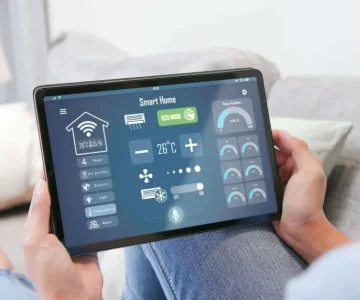Lighting has moved far beyond the simple on-off switch. Modern smart lighting systems give homeowners the ability to fine-tune brightness, colour tone, and even automate schedules, creating a living environment that’s not only functional but deeply personal. With the right design, smart lighting can elevate comfort, improve energy efficiency, and even strengthen home security.
Understanding Smart Lighting Technology
At its core, a smart lighting setup connects various components—such as LED bulbs, switches, sensors, and smart plugs—into a single, controllable network. These devices communicate through wireless connections, enabling control via mobile apps, voice commands, or home automation hubs. The result is a flexible system that can be adapted to suit your lifestyle, whether you want lights that fade gently in the morning or turn off automatically when a room is empty.
Key Elements of a Smart Lighting System
- Smart Bulbs – Adjustable in brightness, colour, and temperature, these bulbs can be controlled remotely or programmed for specific moods and routines.
- Smart Switches – A blend of traditional control and modern automation, allowing both manual use and app-based adjustments.
- Motion Sensors – Perfect for hallways, bathrooms, or entryways, these sensors trigger lights when movement is detected and help avoid unnecessary energy use.
- Smart Plugs – An easy upgrade for existing lamps or fixtures, making them part of your automated lighting system without rewiring.
Why Smart Lighting is Worth the Investment
1. Personalised Control
From cosy evening settings to bright, energising light for work, you can pre-program scenes that suit any activity. Voice integration with platforms like Alexa or Google Assistant means you can change settings hands-free, whether you’re cooking, reading, or relaxing.
2. Energy and Cost Savings
LED-based smart lighting uses far less energy than traditional bulbs and lasts significantly longer. Automated schedules, dimming functions, and occupancy-based controls help reduce electricity usage, leading to noticeable savings on your bills.
3. Security Enhancements
Lighting plays a big role in deterring unwanted visitors. With automated routines, you can make your home look occupied even when you’re away. Motion-activated lights at entrances or along driveways add another layer of protection, especially when paired with security cameras.
4. Integrated Entertainment Experiences
Smart lighting can enhance home cinema and entertainment spaces. A “movie mode” might dim the lights to the perfect level when the projector starts, or sync with your sound system to create immersive effects during a live sports event.
Choosing the Right Smart Lighting Setup
When selecting a system, look for compatibility with your existing smart devices, ease of setup, and the level of customisation available. Consider how you prefer to control your lighting—through an app, voice commands, or automated triggers—and choose products that match your needs.
Energy efficiency should also be a priority. Opt for solutions with built-in dimming, motion detection, and real-time usage tracking so you can adjust habits and save money in the long run.
The Future of Smart Lighting
The next wave of innovation will make lighting even more responsive and eco-friendly. Artificial intelligence is expected to fine-tune brightness and colour automatically based on your routines and the natural light in your home. Sustainable options, such as solar-powered and ultra-efficient fixtures, will become more mainstream, reducing environmental impact while maintaining performance.
Final Thoughts
Smart lighting isn’t just a technological upgrade—it’s a lifestyle enhancement. By blending convenience, efficiency, and design flexibility, these systems allow you to create spaces that respond to your needs in real time. As the technology evolves, expect even more seamless integration with your home’s other systems, making lighting a central part of a smarter, safer, and more sustainable way of living.





